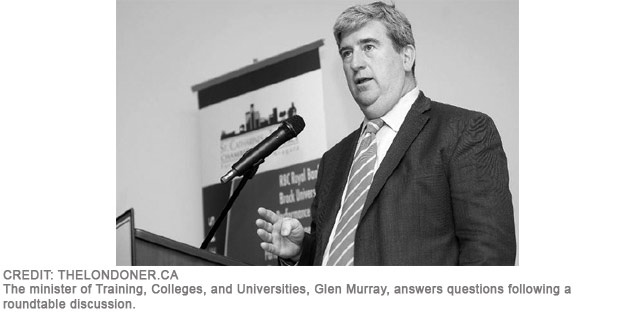MTCU announces innovation strategy

The Ministry of Training, Colleges and Universities recently published a discussion paper called “Strengthening Ontario's Centres of Creativity, Innovation and Knowledge.” The purpose of the paper is to examine the most effective way to bring Ontario's postsecondary education (PSE) up to speed with the international community. While Ontario universities remain on the cutting edge of international research, there are many areas of the PSE sector that need improvement.
The minister of Training, Colleges, and Universities, Glen Murray, answered questions about the proposed changes following a roundtable discussion about them with staff at Fanshawe College in July. He prefaced the interview by saying that he doesn't “think people fully understand yet how fundamental the changes are that are taking place in society.” As we move away from an industrial economy to one that favours innovation, the PSE sector needs to transform accordingly. “People don't primarily make things for a living in Ontario; they discover, they invent, they finance, they engineer, they create, they manage, they design. Most people now don't make ‘things,' they make things better (and) redesign things.” The focus of PSE in the past was to train workers for existing positions as opposed to training them for survival in the industry of their choice.
Murray said that one of the fundamental changes that necessitated the transformation is that “70 per cent of jobs being created in Ontario require post-secondary education. Our universities are not just elite research intensive institutions anymore, they're also institutions of mass education the way high schools are.” Similar to how a high school education is a prerequisite to most jobs today, going forward it will become increasingly difficult to find work that doesn't require a degree or diploma.
With the growing demand for educated, innovative employees, the ministry is looking at alternatives to the traditional model for PSE. While we rely heavily on college, university and co-op programs, the online options are growing. According to Murray, “The virtual online education will be kind of the fourth pillar of education.” It allows students to access any material from any location. This would allow a student to take distance studies with multiple institutions and compile a degree that consists of courses from the top educational institution in each field of study.
Beyond the sources of the educational material changing, the ministry also wants to improve on the credit transfer system. As it stands currently, it's easier for a student at a Swedish university to transfer to the University of British Columbia than it is for an Ontario student to do the same. The ministry has recognized this and is committed to turning it around. “We've had the most tepid credit transfer system in Canada. We have to have a more robust program for recognizing and transferring credits.”
The transformation is one that will take a number of years. “You will not see classrooms with nailed-down seats that can't move with a sage on a stage. We're looking at a much more flexible, much more student-centered learning.”
The students of this age are driving change in the PSE sector because they have the ability to vote with their tuition money and show institutions where their priorities lie by doing so.













